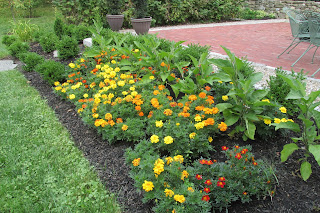If your tulips are finished blooming, might as well get rid of them. I know this is hard advice for frugal sentimental plant lovers to take, but your tulips will never look as good as they did last week. There are a few, some of the Giant Darwin hybrids, that will come back fairly well for a few years, but you have to put up with them looking really crappy until way into July. By then summer is half over.
My choice is to dedicate a garden bed or two to "tulips followed by annuals". The lowly annual has had a hard time in our post modern age. People weary of impatiens have been lured by the siren song of perennials, with their large blossoms and promise of longevity and economy, returning year after year. The back story that no one ever tells you, is the fact that perennials are far from "maintenance free." Have you ever questioned why your gardening friends are so eager to fob off divisions of their perennials? Could it be that they have grown out of bounds, and your friends don't know how to get the monster under control? Sure, just give them to some unsuspecting soul and have a partner in misery.
Perennials need to be deadheaded and divided when they get too big. Otherwise, as in the case of most irises, they will just quit blooming altogether. Or in the case of phlox, if you forget to deadhead, all of your beautiful hybrid colors will revert to the pale lavender of the species. Then of course, there is weeding. Don't even get me started. The peskiest weeds like to mingle their roots with those of their favorite perennials. Daylilies and witch grass are congenial companions, and even if you dig up the daylily, spray wash all of the dirt out of the roots and, by hand, pick out all of the witch grass, some will remain to say "hello" next year.
So, time to reconsider the lowly annual. You have the luxury of choosing variety from year to year. Last year I planted zinnias, cosmos, and snapdragons, and enjoyed the myriad butterflies who came to visit all season long. You can even intersperse vegetables in an annual bed. This year I chose to plant six eggplants and surround them with the elegant colors of French marigolds - red, orange, gold and yellow. The marigolds have an added gift for keeping pests at bay because of their fragrance. In my other bed, I have planted ivory nicotiana and parsley. The nicotiana has a delicate color and fragrance, and should grow to 18" by summer's end.
It is a good idea to change your annuals from year to year. This keeps pests that may have found you from setting up housekeeping the next year. One year I built a temporary trellis out of twigs and planted pole beans. They fix the nitrogen in the soil, and will make next year's flowers even more beautiful. I have made a permanent border of evergreen boxwood along one of my annual beds (The other is bounded by a nice stone wall.) This gives everything form while I wait for the little seedlings to fill out.
For the budget conscious, just get some seed packets early in the season and scatter them on your freshly weeded bed. Incredible flowers for just a few dollars. If you pick the flowers throughout the summer, you will have more! In the fall, after the first frost has killed all your annuals, just pull them out and take them to the compost pile. Then plant your new collection of tulips, (get them from a wholesale dealer in bulk for savings) and dream of spring, when it will be time to do it all again.
The hardest thing about keeping an annual bed going, is that the real estate is so tempting. I can't tell you how many times, I have thought, "Oh maybe I'll plant these wiegielia shrubs I got on sale at the garden center," or, "I'll just put my divided overgrown daylilies here till I figure out what to do with them." I always manage to come to my senses before it is too late.
Exotic annuals and non hardy tropical are making a comeback these days. So if you grandmother's garden annuals just don't seem exciting enough, check out you local garden center. The humble coleus is now available with foliage of amazing colors and shapes. Annual grasses a lot easier to deal with that their perennial cousins.
I hope that I have made the case. If not, check out the following photos of my annual bed last year and the nascent bed of this year. Click on the first picture, and the whole thing will come up in slide show mode.
 |
| last year's zinnias |
 |
| Peony flowering tulips |
 |
| Peony flowering tulips, soon to become a nicotiana bed |
 |
| Tulips in the spring |
 |
| Marigolds and eggplants newly planted two weeks ago |











































